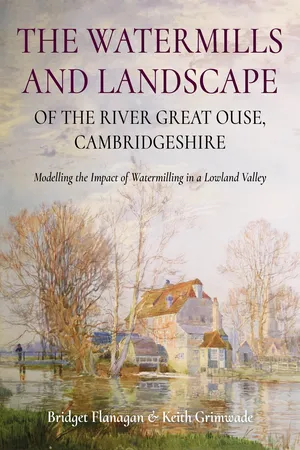
The Watermills and Landscape of the River Great Ouse, Cambridgeshire
Modelling the Impact of Watermilling in a Lowland Valley
- English
- ePUB (mobile friendly)
- Available on iOS & Android
The Watermills and Landscape of the River Great Ouse, Cambridgeshire
Modelling the Impact of Watermilling in a Lowland Valley
About this book
Uncovers the historical significance of water milling along the River Great Ouse using innovative methods, revealing its national prominence and lasting landscape impact. The River Great Ouse in Cambridgeshire has a long history of watermilling, stretching back to at least the 10th century and possibly to the Roman period. The authors use remote sensing (LiDAR), cartographic analysis, fieldwork, documents (especially contemporary litigation) and literary sources to reveal new findings about this fascinating landscape. The Great Ouse's watermills were recorded as the most valuable in England in the Domesday Survey. All their sites are located, several having been long lost, and a comprehensive explanation for their national pre-eminence is given. The expansion of activity in the Middle Ages is investigated through a detailed study of the disputes arising from the competing uses of the river and its floodplain for watermilling, navigation and farming. Channel features that, hitherto, have either been ignored or attributed to natural processes are shown to be the result of milling activity. The continuing impact of watermilling on the landscape until its decline in the second half of the 19th century is analysed. The authors' findings have broader implications for the understanding of the development of watermilling in lowland river landscapes; the evolution of parish boundaries; and the development of multi-channel river forms. They conclude by advocating a mapping methodology that designates landscape features resulting from watermilling as heritage assets, to guide planning decisions.
Frequently asked questions
- Essential is ideal for learners and professionals who enjoy exploring a wide range of subjects. Access the Essential Library with 800,000+ trusted titles and best-sellers across business, personal growth, and the humanities. Includes unlimited reading time and Standard Read Aloud voice.
- Complete: Perfect for advanced learners and researchers needing full, unrestricted access. Unlock 1.4M+ books across hundreds of subjects, including academic and specialized titles. The Complete Plan also includes advanced features like Premium Read Aloud and Research Assistant.
Please note we cannot support devices running on iOS 13 and Android 7 or earlier. Learn more about using the app.
Information
Table of contents
- Front Cover
- Title Page
- Copyright Page
- Contents
- List of figures
- List of tables
- Acknowledgements
- 1. Introduction
- 2. The physical and historical background
- 3. The first watermills: the Roman period to 1066
- 4. A watermilling ‘powerhouse’: the Domesday Mills
- 5. The Age of Backwaters: 1086–
- 6. River Wars: 1515 – matters come to a head
- 7. The Age of Locks: a 17th century technical solution
- 8. Continuity, disputes and cooperation: 1700–1850
- 9. Decline and romantic appreciation: 1850 to the present day
- 10. Modelling and managing the watermilling landscape
- Primary sources
- Bibliography